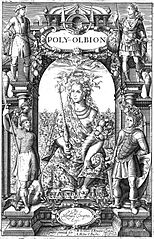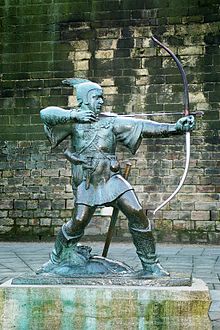Poly-Olbion
 Strona tytułowa poematu Poly-Olbion | |
| Autor | |
|---|---|
| Typ utworu | |
| Wydanie oryginalne | |
| Miejsce wydania | |
| Język | |
| Data wydania | 1612 |
Poly-Olbion - poemat opisowy angielskiego poety Michaela Draytona[1][2], opublikowany po raz pierwszy w 1612 i wydany w pełnej wersji 1622.
Forma
Utwór jest napisany parzyście rymowanym aleksandrynem[3], czyli dwunastozgłoskowym[1] jambicznym sześciostopowcem[4] ze średniówką po sylabie szóstej. Liczy około trzydziestu tysięcy wersów[3][5][6]. Forma poematu uchodzi za dość monotonną[3][7]. W przeciwieństwie do pentametru jambicznego sześciostopowiec - poza strofą spenserowską - jest używany w literaturze angielskiej bardzo rzadko. W XIX wieku posłużył się nim w poemacie Fifine at the Fair Robert Browning[8].
- To grace his goodly Queen, Tames presently proclaims,
- That all the Kentish Floods, resigning him their names,
- Should presently repaire unto his mighty Hall,
- And by the posting Tides, towards London sends to call
- Cleere Ravensburne (though small, remembred them among)
- At Detford entring. Whence as down she comes along,
- She Darent thither warnes: who calles her sister Cray,
- Which hasten to the Court with all the speed they may.
- And but that Medway then of Tames obtain'd such grace,
- Except her country Nymphes, that none should be in place,
- More Rivers from each part, had instantly been there,
- Then at their Marriage, first, by Spenser numbered were.
Treść
Poly-Olbion jest poematem opisowym, przedstawiającym geografię Anglii i Walii[5][9]. Zalicza się do najobszerniejszych dzieł wierszowanych, jakie kiedykolwiek napisano po angielsku[1]. Motywem organizującym opis jest przedstawianie rzek[3]. Prezentowanie topografii angielskich i walijskich hrabstw jest połączone z przywoływaniem dziejów Anglii i Walii, w tym także ich legend[1]. Jakkolwiek poemat należy do najważniejszych dzieł poezji angielskiej, nie cieszy się zainteresowaniem ze strony współczesnych czytelników[1]. Strona tytułowa oryginalnego wydania przedstawia upersonifikowaną Brytanię w sukni, pokrytej obrazami angielskich i walijskich rzek, jak również czterech wodzów, którzy w ciągu wieków zdobywali wyspę: Brutusa Trojańczyka, Juliusza Cezara, Hengesta i Wilhelma Zdobywcy[10]. Wśród historycznych opowieści przekazanych przez Draytona znalazła się też historia Robin Hooda[11]:
- In this our spacious Isle, I thinke there is not one,
- But he hath heard some talke of him and little Iohn;
- And to the end of time, the Tales shall ne’r be done,
- Of Scarlock, George a Greene, and Much the Millers sonne,
- Of Tuck the merry Frier, which many a Sermon made,
- In praise of Robin Hood, his Out-lawes, and their Trade[12].
Zobacz też: The Barons' Wars
Opracowania
Monografię eposu napisała Sara Trevisan[13]. Artykuły na jego temat pisali między innymi Stella P. Revard i William H. Moore. O formie wersyfikacyjnej utworu pisał Parker Duchemin[14].
Przypisy
- ↑ a b c d e Michael Drayton, [w:] Encyclopædia Britannica [online] [dostęp 2017-01-21] (ang.).
- ↑ Arthur Henry Bullen: Drayton, Michael, w: Dictionary of National Biography, 1885-1900, Volume 16. en.wikisource.org. [dostęp 2017-01-21]. (ang.).
- ↑ a b c d Michael Drayton: Poly-Olbion. spenserians.cath.vt.edu. [dostęp 2017-01-21]. (ang.).
- ↑ alexandrine, [w:] Encyclopædia Britannica [online] [dostęp 2017-01-21] (ang.).
- ↑ a b The Life of Michael Drayton (1563-1631). luminarium.org. [dostęp 2017-01-21]. (ang.).
- ↑ Ian Ousby: The Cambridge Paperback Guide to Literature in English. books.google.pl. [dostęp 2017-01-21]. (ang.).
- ↑ Michael Drayton. Poly-Olbion.. Bartleby.com. [dostęp 2017-01-21]. (ang.).
- ↑ Richard M. Hogg, Norman Francis Blake, Suzanne Romaine, Roger Lass, R. W. Burchfield (red.): The Cambridge History of the English Language, Vol. 4. books.google.pl. s. 622. [dostęp 2017-01-21]. (ang.).
- ↑ Przemysław Mroczkowski: Historia literatury angielskiej. Zarys. Wrocław: Ossolineum, 1981, s. 124. ISBN 83-04-00784-3.
- ↑ Michael Drayton, Poly-Olbion (London, 1622).. joh.cam.ac.uk. [dostęp 2017-01-21]. (ang.).
- ↑ John H. Chandler: Robin Hood: Development of a Popular Hero. d.lib.rochester.edu. [dostęp 2017-01-21]. (ang.).
- ↑ Outlaws and Highwaymen. Passage from Michael Drayton’s Poly-Olbion. outlawsandhighwaymen.com. [dostęp 2017-01-21]. (ang.).
- ↑ Sara Trevisan: Michael Drayton's Poly-Olbion: A Study in Perspective. paduaresearch.cab.unipd.it. [dostęp 2017-01-21]. (ang.).
- ↑ Parker Duchemin: Drayton's "Poly-Olbion" and the Alexandrine Couplet. jstor.org. [dostęp 2017-01-21]. (ang.).
Bibliografia
- The Complete Works of Michael Drayton, Now First Collected. Archive.org. [dostęp 2017-01-21]. (ang.).
- Stella P. Revard: The Design of Nature in Drayton's Poly-Olbion. jstor.org. [dostęp 2017-01-21]. (ang.).
- William H. Moore: Sources of Drayton's Conception of "Poly-Olbion". jstor.org. [dostęp 2017-01-21]. (ang.).
- Sara Trevisan: The Impact of the Netherlandish Landscape Tradition on Poetry and Painting in Early Modern England. bura.brunel.ac.uk, 2013. [dostęp 2017-01-21]. (ang.).
Media użyte na tej stronie
A stunning map of England first drawn by Daniel de la Feuille in 1706. Depicts the entirety of England with parts of Ireland, Scotland and the Netherlands. Dutch language title in lower right quadrant. This is Paul de la Feuille’s 1747 reissue of his father Daniel’s 1706 map. The De La Feuille name has been removed from the map and replaced with Ratelband’s. Note in the bottom right quadrant dates this engraving to 1734 and attributes it to J. van Jagen, a prominent Dutch engraver. It was most likely Jagen who re-engraved and updated De La Feuille’s map per Ratelband’s instruction. Prepared for issue as plate no. 16 in J. Ratelband’s 1747 Geographisch-Toneel .
Autor: Autor nie został podany w rozpoznawalny automatycznie sposób. Założono, że to Olaf1541 (w oparciu o szablon praw autorskich)., Licencja: CC-BY-SA-3.0
The Robin Hood Memorial in Nottingham near the castle. Sculptor: James Woodford.
- picture taken by me in 2001
- I license it to GNU-FDL
- Other version:
 File:Nottingham montage.jpg
File:Nottingham montage.jpg








